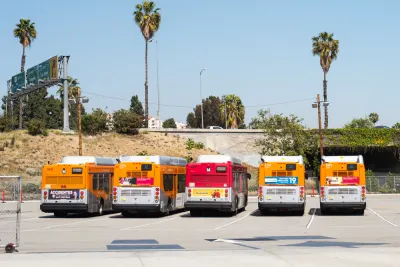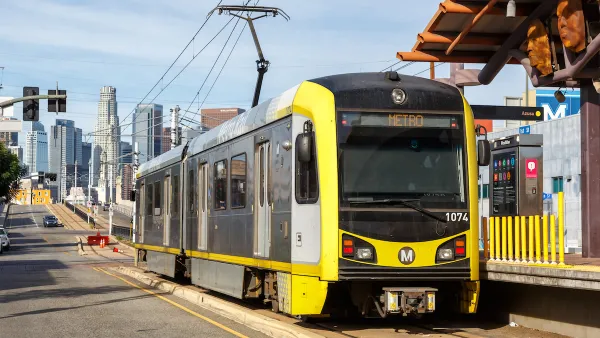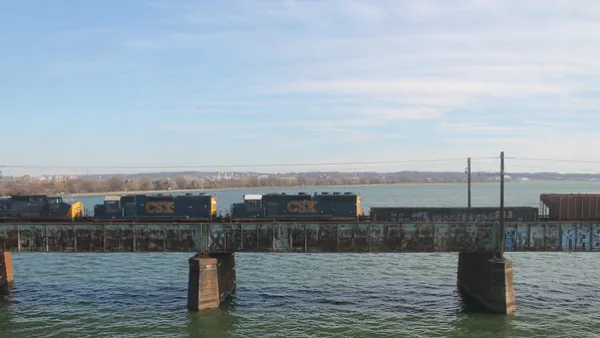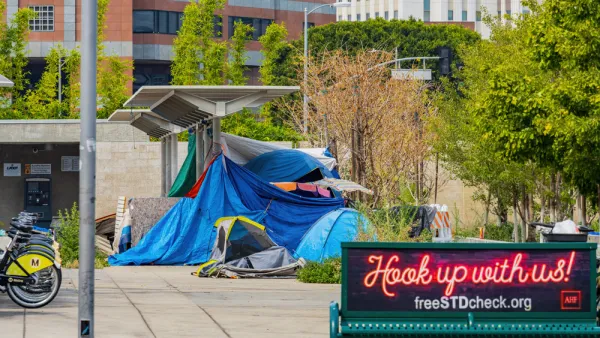Even as extensions to the Gold Line and Measure S seem to paint a brighter future for public transit in Los Angeles, commuters continue to use less public transit, especially buses.

"Since 2009, Metro has opened four new rail extensions at a cost of more than $4 billion. In the same period, rail ridership soared 21%, but bus trips — a much larger share of overall ridership — dropped 18%," writes Laura J. Nelson for the Los Angeles Times.
The reasons for the shrinking use of transit are multiple, according to Nelson's reporting. One is the complexity of serving a city with so many different commerce centers, which requires compromises in bus service. "But tweaks over the years to routes and schedules may have eroded the efficiency of some workhorse bus lines that serve major corridors, or made the routes more confusing for riders," Nelson writes. Nelson also reports that some transit experts see falling bus ridership as a side effect of an improving economy. "As L.A.’s economy has steadily improved, traffic has grown worse, and so has Metro’s on-time performance. Agency figures show that about 76% of buses arrived on time in the 2014 fiscal year." Ride sharing services may be partly to blame as well.
One reason for the decline in bus ridership Nelson does not cite is zoning and density. There's been much talk about how although L.A.'s downtown is becoming more popular, it's hard to build large dense transit-friendly buildings in the city. This phenomenon is noticeable by how few cranes you see in the city's downtown compared to even smaller, slower-growing cities like Chicago. Density continues to be on the minds of many as Measure S and the possibility of stalling the construction of more and taller residential and business buildings looms.
FULL STORY: The Metro can take you farther than ever. Here's why ridership dropped — again

Analysis: Cybertruck Fatality Rate Far Exceeds That of Ford Pinto
The Tesla Cybertruck was recalled seven times last year.

National Parks Layoffs Will Cause Communities to Lose Billions
Thousands of essential park workers were laid off this week, just before the busy spring break season.

Retro-silient?: America’s First “Eco-burb,” The Woodlands Turns 50
A master-planned community north of Houston offers lessons on green infrastructure and resilient design, but falls short of its founder’s lofty affordability and walkability goals.

Test News Post 1
This is a summary

Analysis: Cybertruck Fatality Rate Far Exceeds That of Ford Pinto
The Tesla Cybertruck was recalled seven times last year.

Test News Headline 46
Test for the image on the front page.
Urban Design for Planners 1: Software Tools
This six-course series explores essential urban design concepts using open source software and equips planners with the tools they need to participate fully in the urban design process.
Planning for Universal Design
Learn the tools for implementing Universal Design in planning regulations.
EMC Planning Group, Inc.
Planetizen
Planetizen
Mpact (formerly Rail~Volution)
Great Falls Development Authority, Inc.
HUDs Office of Policy Development and Research
NYU Wagner Graduate School of Public Service




























